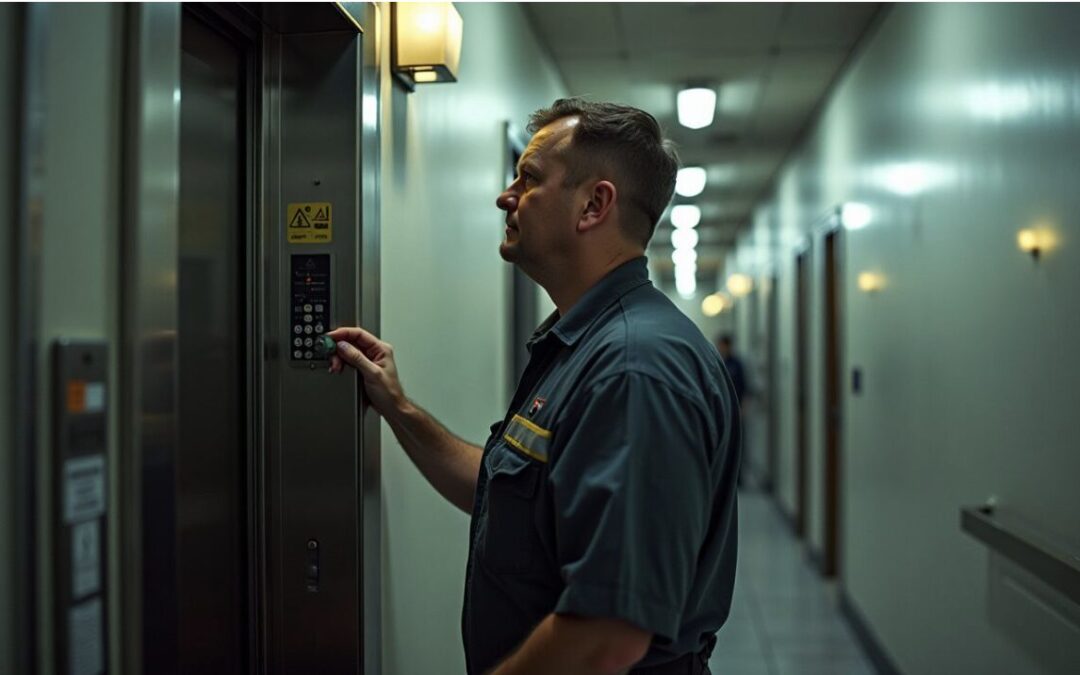Elevators need special care when bad weather hits. Building owners and managers must get ready for storms, snow, and ice. This keeps elevators safe and working well. Schindler Elevator Corporation gives tips on how to do this.
They say to check machine rooms for leaks and close vents to keep water out. Before a storm, move elevators to the middle of the building. Then, turn off the power. This stops people from using them when it’s not safe.
After a storm, look for water damage before turning elevators back on. In winter, watch out for salt and ice near doors. Keep machine rooms warm enough. Clean elevator shafts to stop flooding.
Always write down what you do to fix things. This helps follow rules and stay safe. Taking care of elevators in tough weather is a big job. But it keeps people safe and buildings running smooth.
Preparing for Severe Weather Events
Severe weather can wreak havoc on elevators. Smart prep helps keep them running safely. Secure vents, protect machine rooms, and check power systems before storms hit.
Securing hoistway vents and openings
Secure hoistway vents and openings before severe weather hits. Close all vents at the top of the hoistway. This step keeps water out of the elevator shaft. It also protects vital parts from damage.
Use weather stripping and metal splash guards for extra protection. These tools block water and debris from entering.
A well-sealed hoistway is your first line of defense against weather damage.
Proper sealing prevents costly repairs and downtime. It keeps elevators running safely during storms. Next, we’ll look at how to protect the machine room from extreme weather.
Protecting the machine room
Protect your elevator machine room from severe weather. Install sturdy storm shutters on all openings. Use sump pumps with float switches to stop flooding. Add a surge protection system to guard against power spikes.
Keep a backup power source ready for outages. Check seals on doors and vents to block water entry. Place critical parts on raised platforms above flood levels. Clean the room often to spot leaks fast.
Test all safety gear before storms hit. Have a clear plan to shut down systems if needed. These steps help keep your elevator running safely in bad weather.
Schindler Elevator Corporation advises taking action before storms arrive. Set up a process now for extreme weather events. Practice your plan during slow times. Get help from an expert elevator tech.
Do full checks to find problems early. Fix issues fast to avoid breakdowns. Good care keeps elevators safe when weather turns bad. Your quick work protects both the machine room and people who use the lift.
Winter Weather Maintenance for Elevators
Winter can be tough on elevators. Cold temps and snow can cause issues, but regular checks help keep them running smoothly.
Managing ice and snow buildup
Ice and snow can cause big problems for elevators. Building owners must clear door sills often. This stops ice from building up and jamming doors. It’s key to adjust door springs too.
Warm air rises in elevator shafts, so doors need extra force to close right.
Cleaning is vital for safe elevators in winter. Check cables and pulleys for wear. Make sure hydraulic fluid levels are good. Keep the elevator pit and shaft clean to stop flooding.
These steps help elevators run well in cold weather.
Ensuring door sills are clear to prevent jams
Door sills need constant care in winter. Snow and ice can build up fast, causing jams. Clear sills often to keep doors working right. Use a stiff brush or shovel to remove debris. Apply de-icer to stop ice from forming.
This helps doors open and close smoothly. It also keeps riders safe when entering or exiting.
Proper sill care prevents costly repairs. It reduces the risk of people getting stuck. Check sills daily during bad weather. Clean them as part of regular upkeep. This simple step boosts elevator reliability.
Next, let’s look at how to wrap up your winter prep plan.
Conclusion
Extreme weather poses risks to elevators. Regular checks prevent breakdowns. Proper maintenance ensures safety. AuditMate software tracks these tasks. It alerts owners to needed repairs.
Contact AuditMate today for better elevator care.
FAQs
1. How can I protect my elevator from water damage during hurricanes?
Seal ventilation openings, install flood barriers, and use a climate-controlled system. Check the mainline disconnect and emergency power setup. Don’t forget to test the lift’s phone.
2. What should I do to prep for power outages in severe thunderstorms?
Make sure emergency lighting works. Test the backup power system. Check if the car phone is working. Have a plan for passenger rescue if the lift stops.
3. How often should I inspect my elevator before extreme weather hits?
Do a thorough check at least twice a year – before and after storm season. Look at cables, brakes, and doors. Test all safety features and update your emergency contact list.
4. What’s different about maintaining hydraulic vs. traction elevators for bad weather?
Hydraulic lifts need extra care for fluid levels and seals. Traction ones need more focus on ropes and counterweights. Both types need good lubrication and heating systems checked.
5. How can facility managers prepare for tornadoes and high winds?
Secure all loose parts in the hoistway. Check if the car can handle sudden pressure changes. Make sure emergency brakes are top-notch. Have a solid plan for quick passenger evac.
6. What’s on a good seasonal elevator maintenance checklist?
Include: testing comms systems, checking fluid levels, inspecting cables, testing emergency power, clearing water sensors, and updating emergency procedures. Always follow the latest safety rules.

